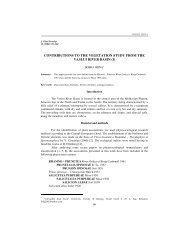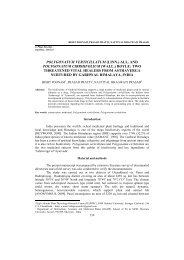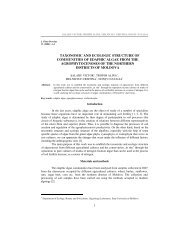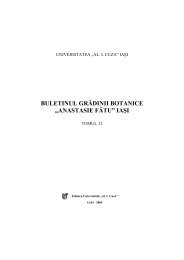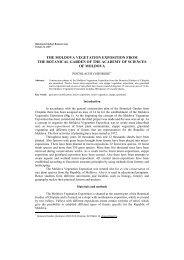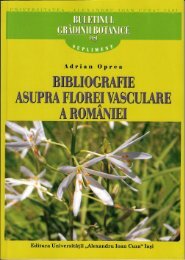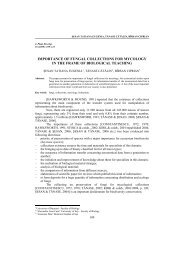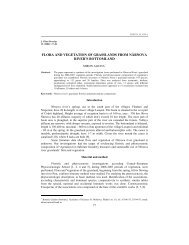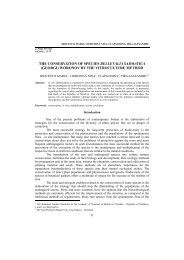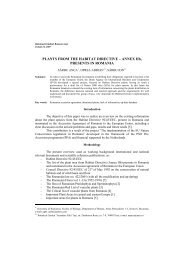ex situ conservation of saussurea porcii degen in y. fedkovych ...
ex situ conservation of saussurea porcii degen in y. fedkovych ...
ex situ conservation of saussurea porcii degen in y. fedkovych ...
Create successful ePaper yourself
Turn your PDF publications into a flip-book with our unique Google optimized e-Paper software.
EX SITU CONSERVATION OF SAUSSUREA PORCII DEGEN IN Y. FEDKOVYCH NATIONAL …<br />
from 400 to 1000 <strong>in</strong>dividuals. The most numerous one has several thousand <strong>in</strong>dividuals and<br />
occupy<strong>in</strong>g an area <strong>of</strong> several tens <strong>of</strong> hectares on the polonyna Glystuvata (the Chyvchyn<br />
Mounta<strong>in</strong>s) (Fig. 1). Only this population from all has a high level vitality constituent<br />
<strong>in</strong>dividuals (Fig. 2) [БАГЛЕЙ, 2011].<br />
Currently, only CHNU Botanic Gardens liv<strong>in</strong>g collection present some specimens<br />
<strong>of</strong> S. <strong>porcii</strong>, unlike all the botanical gardens <strong>of</strong> Ukra<strong>in</strong>e [ЛЕБЕДА, 2011].<br />
Material and methods<br />
Saussurea <strong>porcii</strong> Degen is a hemikryptophyte, herbaceous perennial plant, to 80<br />
cm height, with sessile lanceolate leaves, form<strong>in</strong>g w<strong>in</strong>gs along the stem and <strong>in</strong>florescence<br />
corymbose. From polonyna Glystuvata locality the plant<strong>in</strong>g material has been <strong>in</strong>troduced<br />
CHNU Botanic Gardens, <strong>in</strong> 2007. In the Botanic Garden a place <strong>in</strong> partial shade for<br />
plant<strong>in</strong>g S. <strong>porcii</strong>, and a high soil moisture provided by regular water<strong>in</strong>g this populationlocus<br />
was chosed (Fig. 3).<br />
Monitor<strong>in</strong>g the phenological stages was carried out by conventional methods,<br />
recommended by the Botanical Gardens <strong>of</strong> USSR Council [МЕТОДИКА<br />
ФЕНОЛОГИЧЕСКИХ НАБЛЮДЕНИЙ В БОТАНИЧЕСКИХ САДАХ СССР, 1979],<br />
and mathematical process<strong>in</strong>g <strong>of</strong> phenological observations were carried out accord<strong>in</strong>g to the<br />
method <strong>of</strong> the Central Botanical Garden [КРАТКОЕ ПОСОБИЕ ПО<br />
МАТЕМАТИЧЕСКОЙ ОБРАБОТКЕ ДАННЫХ ФЕНОЛОГИЧЕСКИХ<br />
НАБЛЮДЕНИЙ, 1972]. The study <strong>of</strong> seed production was carried out accord<strong>in</strong>g to the<br />
guidel<strong>in</strong>es by Т. О. RABOTNOV [РАБОТНОВ, 1992] and VAYNAGY [ВАЙНАГИЙ,<br />
1974].<br />
Results and discussions<br />
The International Agenda for Botanic Gardens <strong>in</strong> Conservation emphasizes that<br />
<strong>conservation</strong> <strong>of</strong> rare species <strong>ex</strong> <strong>situ</strong> is the ma<strong>in</strong> task and its aim is the creation <strong>of</strong> a reserve<br />
stock for the possibility <strong>of</strong> active recovery <strong>in</strong> nature [МЕЖДУНАРОДНАЯ<br />
ПРОГРАММА БОТАНИЧЕСКИХ САДОВ ПО ОХРАНЕ РАСТЕНИЙ, 2000]. As for<br />
successful repatriation should be <strong>ex</strong>plored more fully the biological characteristics, which is<br />
possible only <strong>in</strong> <strong>ex</strong> <strong>situ</strong> conditions, we are study<strong>in</strong>g the biology <strong>of</strong> develop<strong>in</strong>g and<br />
reproduction <strong>of</strong> S. <strong>porcii</strong> and it is a preparatory stage to the restoration <strong>in</strong> nature.<br />
The results <strong>of</strong> the study <strong>of</strong> phenological rhythm <strong>of</strong> S. <strong>porcii</strong> <strong>in</strong> the collection <strong>of</strong> the<br />
CHNU Botanic Garden dur<strong>in</strong>g 2007 – 2011 years are presented <strong>in</strong> Tab. 1. In the spr<strong>in</strong>g, S.<br />
<strong>porcii</strong> beg<strong>in</strong>s grow<strong>in</strong>g season <strong>in</strong> CHNU Botanic Garden <strong>in</strong> early April, when average daily<br />
air temperature did not fall below +5 ºC, the bud <strong>of</strong> resumption elongates, shoots and leaves<br />
starts to grow. About a week after the stable transition <strong>of</strong> mean daily air temperatures over<br />
+10 ºC an <strong>in</strong>florescences are formed <strong>in</strong> the generative shoots, on average, this occurs early<br />
<strong>in</strong> the second decade <strong>of</strong> May, <strong>of</strong>ten co<strong>in</strong>cid<strong>in</strong>g with the transition <strong>of</strong> daily average<br />
temperatures over +15 ºC. From the beg<strong>in</strong>n<strong>in</strong>g <strong>of</strong> grow<strong>in</strong>g season before the flower<strong>in</strong>g<br />
passes near 88 days (Table 2). It comes <strong>in</strong>to flower <strong>in</strong> the last third <strong>of</strong> June – mid <strong>of</strong> July,<br />
until early <strong>of</strong> August. The earliest onset <strong>of</strong> phenophases had been observed <strong>in</strong> 2009 – the<br />
152



